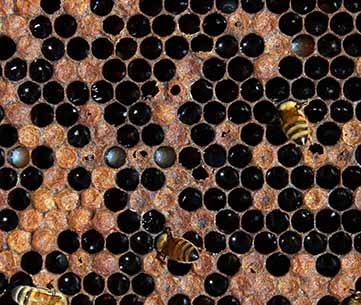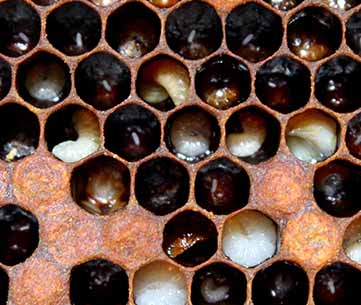Knowing one of the Big Six Bee Diseases
Six diseases that affect honey bees should be recognized by beekeepers. Some are uncommon, and it’s unlikely that you’ll ever come across them. Some are more typical (like Nosema and chalkbrood), therefore it’s crucial to know what to do if they show up. Some are really serious, like American foulbrood, and you need to know how to spot and handle them.

When you examine your bees, you should be on the lookout for two things:
- proof of the monarch (look for eggs)
- indications of health issues (look for the symptoms I describe below).
American foulbrood (AFB)
A terrible bacterial disease known as American foulbrood (AFB) targets larvae and pupae. Leaving this significant threat uncontrolled will kill your entire colony because it is highly communicable to bees (not people). It’s the worst bee illness there is. Some signs include: Infected larvae turn from a healthy pearly white to a tan or dark brown color and pass away after being capped.
Capsules of dead brood sink inward (become concave), and frequently have minute holes visible.
The capped brood pattern changes from being compact to becoming sporadic and erratic. This is sometimes known as a “shotgun” pattern (see the color photo part of this book for further information).
The cappings’ outside may appear oily or damp.
check our article about Bee diseases: Diseases in young bees
 If you notice these symptoms, you can identify an (AFB) by poking a toothpick or matchstick into the dead brood, stirring it up, and then slowly pulling the object out. As you take the toothpick out of the cell, pay attention to the substance that is being dragged out. (AFB)will destroy a brood that is stringy and ropey.
If you notice these symptoms, you can identify an (AFB) by poking a toothpick or matchstick into the dead brood, stirring it up, and then slowly pulling the object out. As you take the toothpick out of the cell, pay attention to the substance that is being dragged out. (AFB)will destroy a brood that is stringy and ropey.
See “Spotting Problems” in this book’s color-photo section for more information. out about 14 inch (like pulling taffy). That examination can establish the presence of (AFB). Look closely at the dead pupae as well. Some may have tongues that stick out from the cell wall at an angle. This disease could also have a distinguishing smell. Most people describe it as having a “foul” scent (like a pot of old-fashioned horse glue). Your bees may have AFB if you smell something fishy and it stays in your nose after you leave the hive.
Ask your state bee inspector to verify your diagnosis as soon as you suspect that your bees actually have AFB. In the US, state laws govern how people with (AFB) are treated. Your hives and other equipment will probably need to be burned or destroyed if (AFB) is present. Why take such extreme measures? Even on outdated, disused equipment, sleeping AFB spores can be active for up to 70 years.
By administering antibiotics to your colonies in the spring and fall that have been cleared for use with honey bees, you can aid in preventing the start of AFB. There are now two products available: Tylan (tylosin tartrate) and Terramycin (oxy-tetracycline). Suppliers of bee equipment sell these drugs. Follow the directions for administration carefully on the product package.

Never buy used, outdated equipment. Regardless of how alluring the offer might be or how well you know the seller. The AFB-causing spores can linger in the apparatus for decades if the bees that originally called that hive home ever had the disease. No amount of cleaning, washing, sanding, or scrubbing will help. Please begin your new beekeeping endeavor by investing in brand-new, hygienic equipment.
Thank you for reading our article. If you are interested in beekeeping, you must learn about the types of diseases that affect the hive. Do not forget to read our article about Beekeeping safety tips in spring.